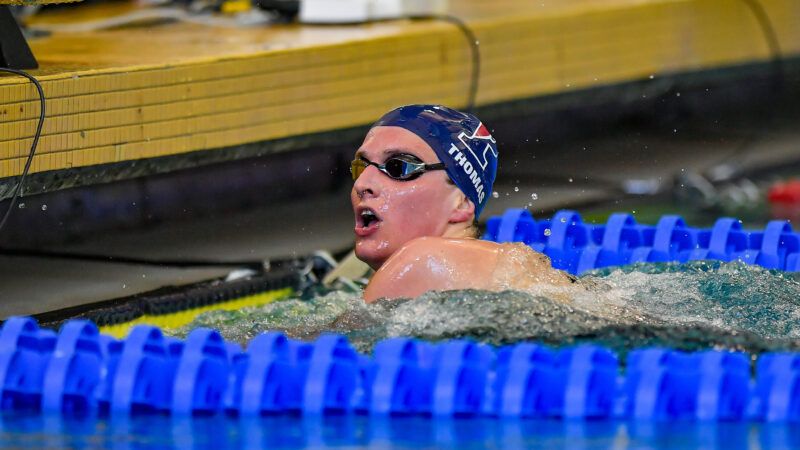Lia Thomas Swims to Victory Under NCAA's Controversial Standards for Trans Competitors
Clocking in at a time of 4:33.24, Lia Thomas becomes the first trans swimmer to win gold at the NCAA Division I women’s swimming championship.

Collegiate women's swimming and diving kicked off its NCAA Division I championships on March 16, and the season has been rife with controversy over Lia Thomas, the first transgender NCAA Division I women's swimming champion.
Thomas, a student-athlete at the University of Pennsylvania, competed on Penn's men's swimming and diving team for three years. While competing among men, Thomas posted decent times, but was far from qualifying for the men's NCAA Division I championships.
After passing all of the NCAA's rules for trans competitors, Thomas shattered records this season for the Ivy League school's women's team. In fact, Thomas' times were only slightly behind one of the greatest female swimmers to ever dive into the pool: Katie Ledecky.
Olympian Katie Ledecky swam the fastest time ever recorded in the women's 500-yard freestyle at 4:24.06, which stands as the current NCAA, American, and US Open record. Tonight, Thomas won the 500-yard freestyle event with a time of 4:33.24, a full two and a half seconds ahead of the second place finisher. Her performance lands her as the 16th fastest female swimmer of all time in this event.
An athlete's success largely hinges on whether or not she has talent—both raw and earned. Many athletes take "trust the process" as a mantra, but there's a sense in collegiate swimming that the process has broken down.
A few weeks before the championships, USA Swimming announced new standards for transitioning swimmers; transgender athletes would have to show a concentration of testosterone below 5 nmol/L for a continuous period of 36 months and provide "evidence that the prior physical development of the athlete as a male…does not give the athlete a competitive advantage over the athlete's cisgender female competitors." The NCAA has acknowledged "a competitive difference in the male and female categories and the disadvantages this presents in elite head-to-head competition," but determined it would be "unfair" and "potentially detrimental on schools and student-athletes intending to compete in 2022 NCAA women's swimming championships" to follow the new standards (which Thomas would have failed to meet).
Broader legal and social acceptance for trans people has been a force for good, allowing them to live freely and authentically. And Thomas has been brave in the face of significant vitriol for competing in a sport where the ruling body has declared her eligible. But unlike areas such as respectful pronoun use, availability of gender-neutral bathrooms, and recognition of transition on legal documents, sports at the elite level are zero-sum. Thomas' success is causing a crisis of confidence in women's sports, which have long been a source of pride for elite female athletes despite the fact that they knew they couldn't compete on equal footing with men.
The editor in chief of Swimming World Magazine, John Lohn, wrote, "It is a pathetic and misguided state that any argument against Thomas' participation is immediately deemed to be an indication of transphobia." By protecting one athlete out of fear of backlash, many other athletes have been denied a real shot at the top spot on the podium. There are roughly 15,000 female collegiate swimmers in the U.S., but only 1.8 percent of them even qualify for the elite NCAA Division I championships, let alone compete in the finals (limited to 8 lanes) or stand on the winner's podium (top 3 performers).
Washington Post columnist Megan McArdle frames it best: "We didn't create separate leagues to reinforce the special feminine identity of female athletes; if anything, women's athletics was supposed to break down such divisions. The separation is a nod to biology." The very existence of women's sports is tied to the fact that, by biological design, women cannot hold their own while competing with men. By separating female athletes from their male counterparts, women had the chance to display their own extraordinary talent on a more even playing field (or swimming pool).
As a former NCAA Division I swimmer, I've tried to calculate how much total time I spent swimming or training, and it's in the ballpark of 21,900 hours—2 and a half years of my life. Lia Thomas spent a majority of those same hours training with the advantage of greater muscle density and bone mass, a larger heart, and deeper lung capacity. In the end, there can only be three people on the podium, and who ends up there is about biology and luck, as much as it is about skill and perseverance.
But when Lia Thomas stepped up on the block for what ended up being a gold medal-winning performance, I couldn't help but notice how the competitors in the lanes beside her, who trained just as hard and just as long, looked defeated even before the starter said, "take your mark." And I'm afraid that fewer young women will choose to put on their matching swimsuits, goggles, and caps to dive into a cold pool each and every morning, because they lack confidence in what the rules will be when they get to the pinnacle of their careers and whether they will have even a fighting chance at being a champion.
